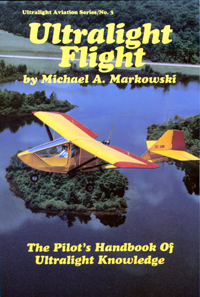

Ultralight Flight
The Pilot's Handbook of Ultralight Knowledge
Michael A. Markowski
A thorough knowledge of the hows and whys of ultralight flight — the kind that transcends basic piloting techniques — is an absolute requirement of the complete aviator. For those who want to be the most competent pilot possible, this authoritative new book unravels the "mysteries" of low speed flight in an easily understood, fun-to-read style.
The information presented in Ultralight Flight should be second nature to anyone who intends to be the best pilot he possibly can. Ultralight Flight is your key to unlocking the mysteries of flight — your guide to "intelligence-in-the-sky".
Ultralight Flight is divided into four sections, neatly packaging the primary knowledge realms of the new flying:
Section One - Introduction To Ultralights presents the complete "ultralight vocabulary". It also includes a fascinating review of the intriguing early days of ultralight flight - never before published!
Section Two - Ultralight Aerodynamics, once and for all, reveals the truth about low speed flight. It begins with a discussion on the nature of the atmosphere and its vital importance to flight. Once air begins to move, it changes character and gives rise to The Force — the only reason flights exists! The study of airflow will enlighten you to the mechanisms of the stall. Pilots argue over how lift is generated — Ultralight Flight tells it like it is. Learn the importance of streamlining. A special chapter vividly describes the amazing ultralight wing and how it works.
Section Three - Ultralight Handling Qualities, delves into the specialties of ultralight aircraft "manners" including stability and control, as well as trim. It will impress upon you the vital importance of proper CG location. It tells why ultralights fly the way they do and allows you to predict how any ultralight should handle. A chapter is then devoted to the peculiarities of canards and flying wings.
Section Four- Ultralight Performance deals with power and speed. It starts with a chapter on the four main forces of flight and their relationships during climb, cruise and glide. A typical ultralight is then investigated for its various performance characteristics and how they change with altitude, power, wingspan, bank angle, propeller size, drag, flaps, ground effect, etc. Finally, operational performance is reviewed and criteria established to determine qualities desirable in a good ultralight design.
